You're using an outdated browser. Please upgrade to a modern browser for the best experience.
Please note this is a comparison between Version 2 by Catherine Yang and Version 1 by Hristo Petkov.
1-amidoalkyl-2-naphthol derivatives are of increasing interest due to their biological activities and further use in the preparation of other important bioactive molecules, such as aminoalkyl naphthols and oxazines.
- 1-amidoalkyl-2-naphthol
- bioactivity
- aminoalkyl naphthol
- oxazine
1. Introduction
The 1,3-aminooxygenated functional motif exists in a variety of natural products [1,2,3,4][1][2][3][4] as well as in a number of marketed drugs [5,6,7,8,9,10][5][6][7][8][9][10]. Sedridine, allosedridine, febrifugine, nikkomycin Z, and negamycin, bearing 1,3-aminooxygenated moiety, are naturally occurring compounds some of which possess antifungal and antibacterial properties [1,2,3,4][1][2][3][4]. Ritonavir and lopinavir, approved antiretroviral drugs against HIV/AIDS [5,6][5][6]; haloperidol, an antipsychotic drug [7]; venlafaxine and desvenlafaxine, antidepressant medications [8]; vildagliptin, an antidiabetic drug [9]; and tramadol, a synthetic analgesic [10], are marketed drugs which also feature the 1,3-aminooxygenated motif. As can be seen, the list of bioactive molecules containing the 1,3-aminooxygenation pattern is fairly long, which justifies and encourages the search for other valuable and pharmaceutically interesting compounds bearing this functional motif.
Naphthalene compounds are known to exhibit diverse biological activities. They possess anti-inflammatory [11], antibacterial [12,13,14][12][13][14], cardiovascular [15], antiproliferative [16], and antiviral [17] properties. A pharmaceutically interesting class of substances is the 1-amidoalkyl-2-naphthols, which possess the important 1,3-aminooxygenated moiety in their molecular structures, as well as an amide linkage, along with a naphthalene ring (Figure 1).
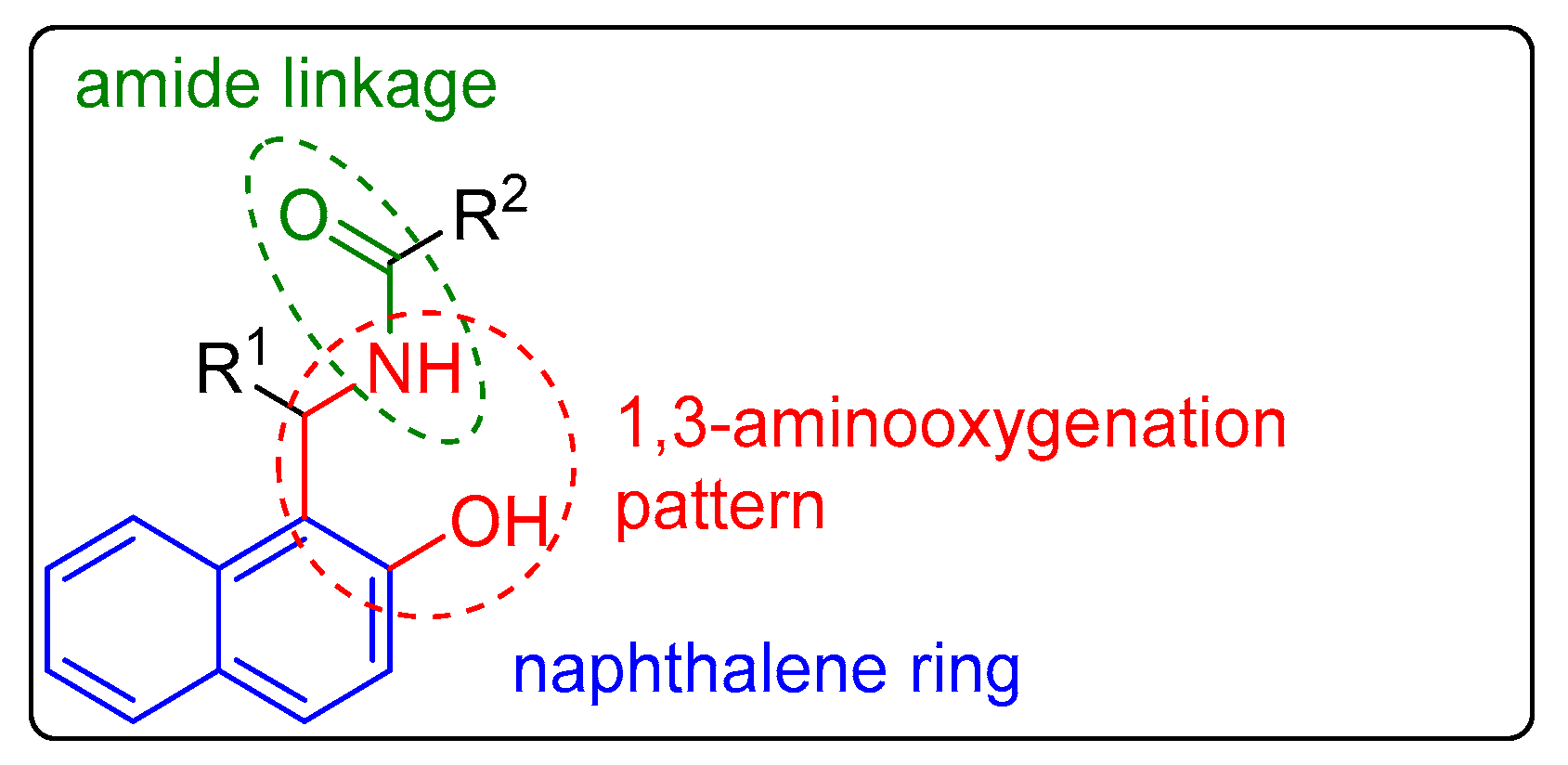
Figure 1.
General structure of 1-amidoalkyl-2-naphthols.
2. Amidoalkyl Naphthols as Bioactive Molecules
The 1-amidoalkyl-2-naphthols possess diverse biological properties, such as antiviral, antibacterial, antifungal, and antiparasitic qualities [18,19,20,21,22][18][19][20][21][22]. Furthermore, members of this family are promising antioxidants, which also show cholinesterase and α-glucosidase inhibitory activities [23,24,25][23][24][25].
Abou-Elmagd and colleagues evaluated the in vitro antibacterial and antiviral activities of a series of amidoalkyl naphthol derivatives featuring pyrazole or indole fragments [18]. The most potent compounds are illustrated in Figure 2. The results of the antibacterial test revealed that compounds 1 and 4 show high potency against Staphylococcus aureus, whereas compounds 2 and 3 have more pronounced inhibitory effects towards Klebsiella pneumoniae and Bacillus subtilis, respectively. All four derivatives demonstrated comparable antibacterial activities to the used reference, gentamicin. In terms of antiviral properties, the most active compounds against avian influenza virus (H5N1) were found to be 3 and 5, which showed similar results to the control, zanamivir.

Figure 2.
Representative amidoalkyl naphthol derivatives with different antibacterial and antiviral properties.
Bananezhad and co-workers synthesized a series of 14 amidoalkyl naphthols bearing an azo-moiety and subjected them to in vitro antimicrobial assays [19]. It was observed that none of the derivatives showed better antibacterial activities than the reference drugs trimethoprim/sulfamethoxazole (SXT) and ciprofloxacin. However, the results from the antifungal test were very promising, since five substances (compounds 6–10, Figure 3) exhibited better potencies against Aspergillus niger than the standard drugs fluconazole and miconazole.

Figure 3.
Antifungal amidoalkyl naphthols.
Another study by Manavi et al., revealed the in vitro anti-Helicobacter pylori activities of various amidoalkyl naphthols [20]. The obtained results illustrated that many of them show promising potency with compound 11 (Figure 4) being the most active against this bacteria.
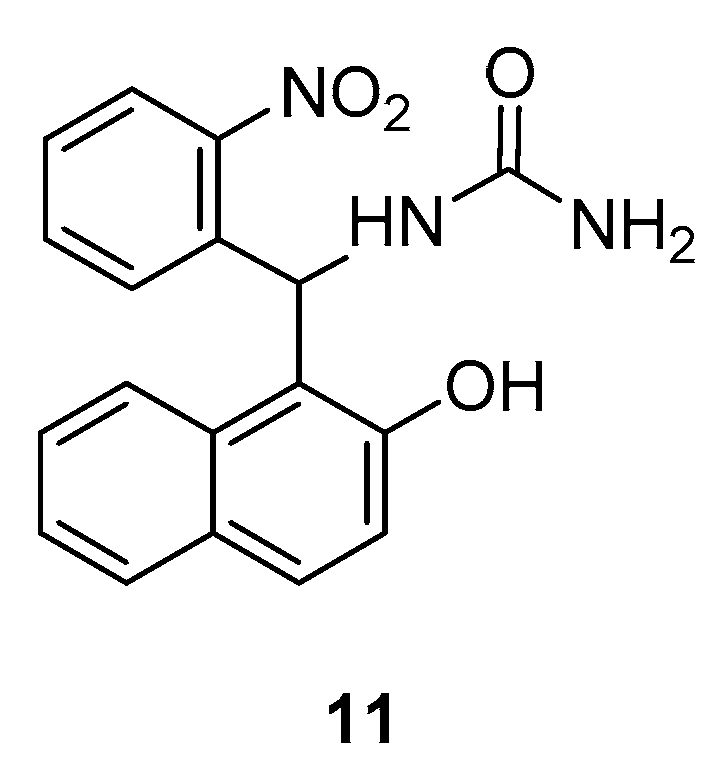
Figure 4.
Promising anti-
Helicobacter pylori
agent from the amidoalkyl naphthol class.
Rahimizadeh et al., used different benzaldehydes and long-chain amide derivatives to prepare a number of amidoalkyl naphthols, and examined their antibacterial properties in vitro [21]. The results indicated that compounds 12–18 (Figure 5) were the most potent against Staphylococcus aureus, exhibiting better activity than the reference, gentamicin.
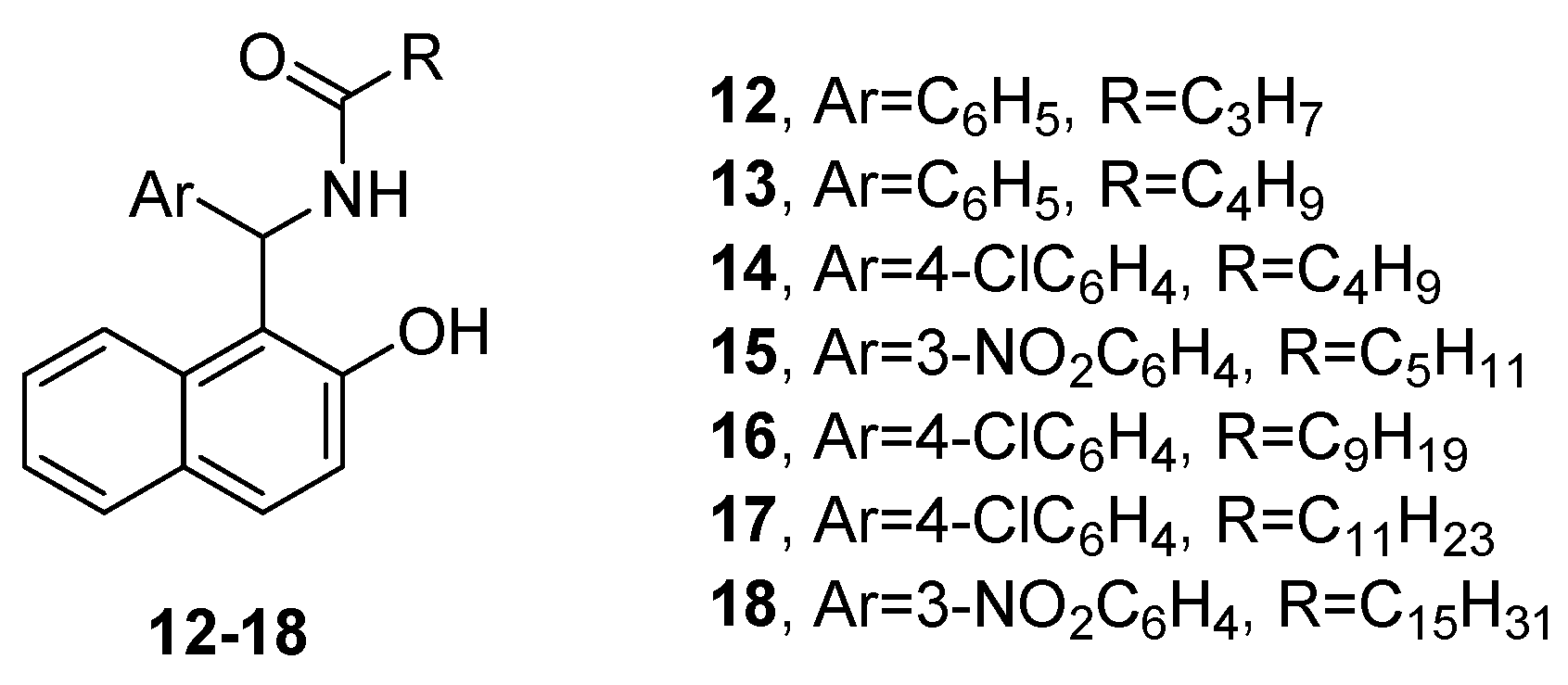
Figure 5.
Amidoalkyl naphthols potent against
Staphylococcus aureus.
Rode and co-authors reported the antiparasitic activity of a series of 23 amidoalkyl naphthol derivatives [22]. As a result of an in vitro screening against Leishmania donovani, followed by a molecular docking study and an in silico study of the ADME (absorption, distribution, metabolism, and excretion) properties of the molecules, four of them (compounds 19–22, Figure 6) were distinguished as the most promising anti-leishmanial agents possessing good drug-like characteristics.

Figure 6.
Amidoalkyl naphthols with antiparasitic properties.
Boudebbous et al., synthesized 19 amidoalkyl naphthols and evaluated their cholinesterase and α-glucosidase inhibitory activities [23]. The results of the in vitro assays were backed by a docking study of selected derivatives. The properties of compounds 23 and 24 (Figure 7) were found to be very promising since both substances showed better inhibition on cholinesterase than the reference drug galantamine. Derivative 24 was also the most potent one in the α-glucosidase assay and exhibited a greater inhibitory effect than quercetin and acarbose, which were used as standards.

Figure 7.
Amidoalkyl naphthols proven as potent cholinesterase and α-glucosidase inhibitors.
In vitro and in silico studies by Boudebbous et al., aimed to estimate the biological potential of another two amidoalkyl naphthol derivatives—NDHA [24] and BHMA [25] (Figure 8). Both compounds exhibited promising antioxidant properties, and in addition, NDHA was proven to be a potent acetylcholinesterase and α-glucosidase inhibitor.
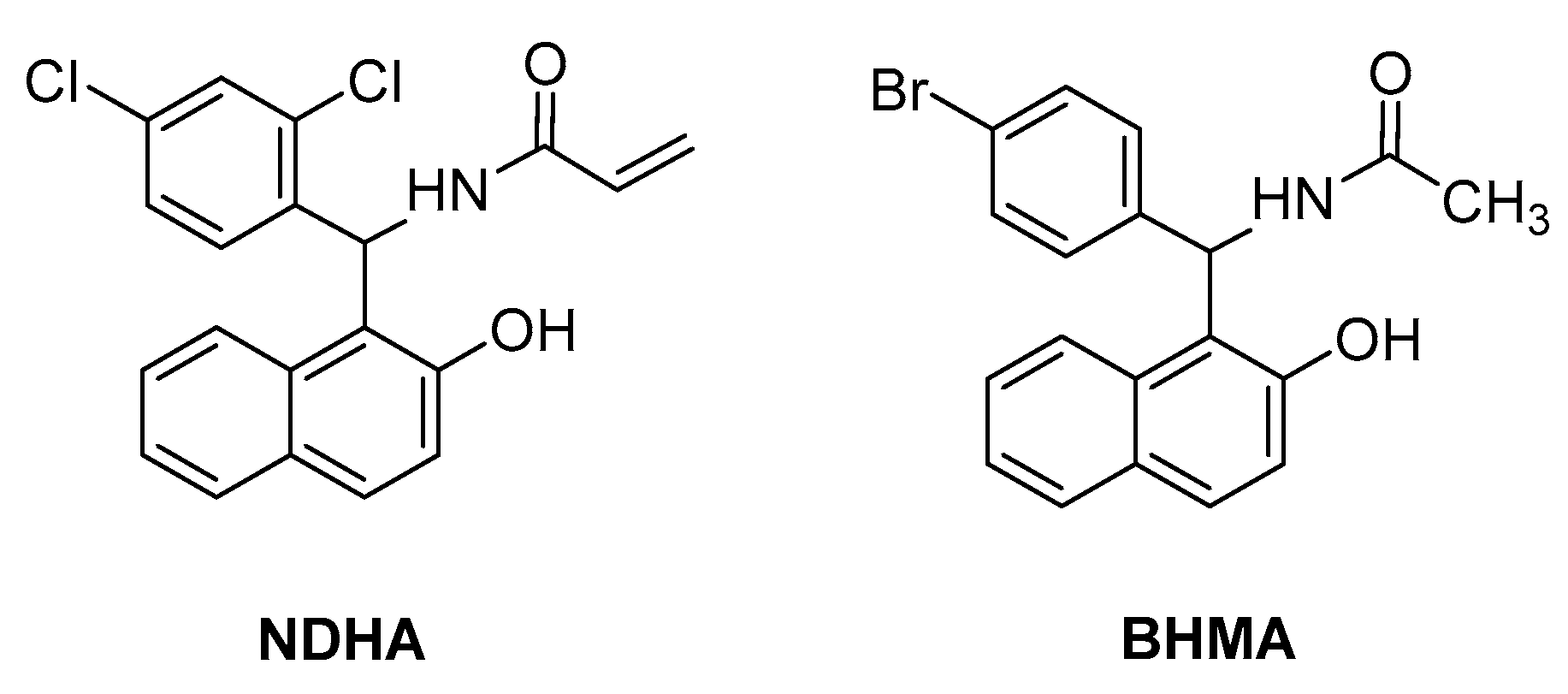
Figure 8.
Amidoalkyl naphthols with promising antioxidant properties.
Based on the pronounced biological activities that amidoalkyl naphthols exhibit, it can be concluded that this class of compounds has the potential to become an important starting point for the pharmaceutical industry. However, more in-depth studies are needed in order to evaluate the physiological effect of these substances.
3. Amidoalkyl Naphthols as Building Blocks
As well as possessing interesting properties, amidoalkyl naphthols are valuable building blocks for the preparation of other bioactive molecules. They can be easily converted to aminoalkyl naphthols, the so-called Betti bases, via hydrolysis or reduction [23,26,27,28,29][23][26][27][28][29] (Scheme 1). These are of great importance because of their biological activities, such as enhancing antitumor agents’ cytotoxicity [30], and hypotensive and bradycardiac effects [31]. In addition, these compounds can be used as ligands to chelate with organometallic reagents in asymmetric synthesis and catalysis [32,33,34][32][33][34].

Scheme 1.
Hydrolysis and reduction of amidoalkyl to aminoalkyl naphthols.
Furthermore, the intramolecular cyclization of amidoalkyl naphthols produces 1,3-oxazines via the Vilsmeier–Haack reaction (Scheme 2). These compounds have also attracted interest because of their potential as antibiotics, antitumor agents, analgesics, and anticonvulsants [35].
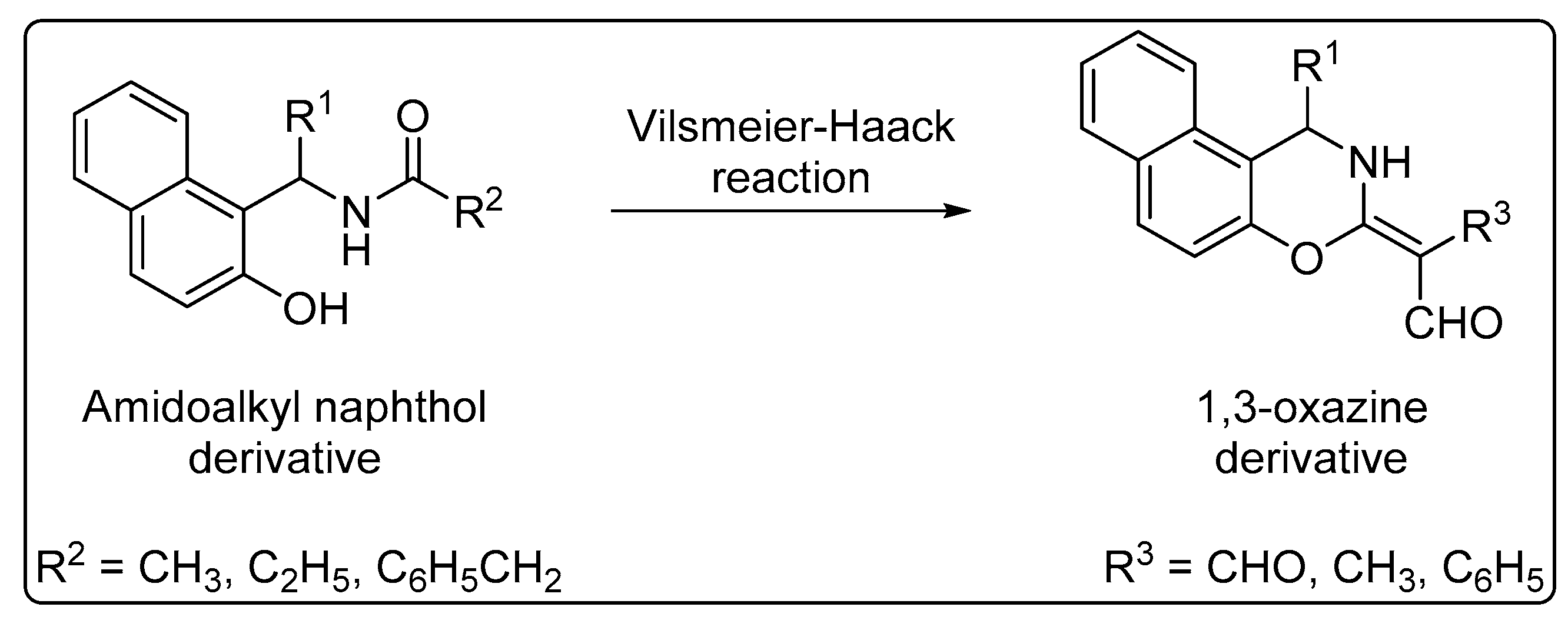
Scheme 2.
Intramolecular cyclization of amidoalkyl naphthols to 1,3-oxazines.
4. Synthesis of Amidoalkyl Naphthols via Multicomponent Mannich Condensation
Although many routes to obtain similar structures including phenols and naphthols, e.g., via transition-metal catalysis, have been reported [38[36][37][38][39],39,40,41], multicomponent Mannich condensation continues to be the primary way to achieve the synthesis of amidoalkyl naphthols.
Multicomponent reactions are of increasing importance in organic synthesis for the preparation of complex and diverse molecules through the formation of carbon–carbon and carbon–heteroatom bonds. These reactions involve three or more compounds mixed simultaneously in one vessel that react with each other and give the final target product without having to isolate the intermediates. Hence, one-pot multicomponent synthesis is in accordance with the principles of green chemistry, which require the development of new substances and reaction conditions that have the potential to provide benefits to chemical synthesis to meet certain requirements regarding resource and energy efficiency, operational simplicity, and product selectivity, as well as including environmental and health protections through reducing toxic solvent use and amount of waste produced as much as possible [42,43,44,45,46][40][41][42][43][44]. An example of such a reaction is the Mannich condensation of 2-naphthol with aldehydes and amide derivatives, in the presence of a catalyst, which is used as a practical synthetic route towards 1-amidoalkyl-2-naphthols [47][45] (Scheme 3). The same reaction is applicable to the synthesis of 1-carbamatoalkyl-2-naphthols when carbamates are used as reaction partners [48,49,50,51,52,53][46][47][48][49][50][51]. However, the reports on the synthesis of 1-carbamatoalkyl-2-naphthols over the last 3 years are limited [54,55][52][53]. The generally accepted reaction mechanism of the acid-promoted three-component Mannich condensation of 2-naphthol with aldehydes and amides proceeds with the initial formation of highly reactive ortho-quinone methides. These intermediates react with an amide via nucleophilic conjugate addition to form 1-amidoalkyl-2-naphthol (Scheme 3) [56,57,58][54][55][56].

Scheme 3.
Synthesis of amidoalkyl naphthols via multicomponent Mannich condensation and plausible mechanism.
References
- Zaidan, R.K.; Evans, P. Strategies for the Asymmetric Construction of Pelletierine and its Use in the Synthesis of Sedridine, Myrtine, and Lasubine. Eur. J. Org. Chem. 2019, 2019, 5354–5367.
- Larwood, D.J. Nikkomycin Z—Ready to Meet the Promise? J. Fungi 2020, 6, 261.
- Hagenmaier, H.; Wolf, G.; Dähn, U.; Höhne, H.; König, W.A.; Zähner, H. Stoffwechselprodukte von Mikroorganismen. 154. Mitteilung. Nikkomycin, ein neuer hemmstoff der chitinsynthese bei pilzen. Arch. Microbiol. 1976, 107, 143–160.
- Hamada, M.; Tadeuchi, T.; Kondo, S.; Ikeda, Y.; Naganawa, H.; Maeda, K.; Okami, Y.; Umezawa, H. A new antibiotic, negamycin. J. Antibiot. 1970, 23, 170–171.
- Chandwani, A.; Shuter, J. Lopinavir/ritonavir in the treatment of HIV-1 infection: A review. Ther. Clin. Risk Manag. 2008, 4, 1023–1033.
- Zeldin, R.K.; Petruschke, R.A. Pharmacological and therapeutic properties of ritonavir-boosted protease inhibitor therapy in HIV-infected patients. J. Antimicrob. Chemother. 2004, 53, 4–9.
- Granger, B.; Albu, S. The Haloperidol Story. Ann. Clin. Psychiatry 2005, 17, 137–140.
- Thase, M. Venlafaxine and Desvenlafaxine. In The American Psychiatric Association Publishing Textbook of Psychopharmacology; Schatzberg, A.F., Nemeroff, C.B., Eds.; American Psychiatric Association Publishing: Arlington, MA, USA, 2017.
- Sonia, T.A.; Sharma, C.P. Diabetes mellitus—An overview. In Oral Delivery of Insulin; Elsevier: Amsterdam, The Netherlands, 2014; pp. 1–57.
- Leppert, W. Tramadol as an analgesic for mild to moderate cancer pain. Pharmacol. Rep. 2009, 61, 978–992.
- Huang, M.-H.; Wu, S.-N.; Wang, J.-P.; Lin, C.-H.; Lu, S.-I.; Liao, L.-F.; Shen, A.-Y. Biological study of naphthalene derivatives with antiinflammatory activities. Drug Dev. Res. 2003, 60, 261–269.
- El-Wahab, A.H.F.A. Synthesis, Reactions and Evaluation of the Antimicrobial Activity of Some 4-(p-Halophenyl)-4H-naphthopyran, Pyranopyrimidine and Pyranotriazolopyrimidine Derivatives. Pharmaceuticals 2012, 5, 0745.
- Göksu, S.; Uguz, M.; Özdemir, H.; Secen, H. A Concise Synthesis and the Antibacterial Activity of 5,6-Dimethoxynaphthalene-2-carboxylic Acid. Turk. J. Chem. 2005, 29, 199–205.
- Dammak, L.; Kammoun, M.; Allouche, N.; Ammar, H.; Abid, S. Synthesis and antibacterial activity of 2-amino chromenes arising cyanoiminocoumarins and β-naphthol. Org. Commun. 2017, 10, 32–39.
- Shen, A.-Y.; Wu, S.-N. Effects of 1-pyrrolidinylmethyl-2-naphthol on contractile force and ionic current in cardiac and vascular smooth myocytes. Drug Dev. Res. 1998, 44, 87–96.
- Minutolo, F.; Sala, G.; Bagnacani, A.; Bertini, S.; Carboni, I.; Placanica, G.; Prota, G.; Rapposelli, S.; Sacchi, N.; Macchia, M.; et al. Synthesis of a Resveratrol Analogue with High Ceramide-Mediated Proapoptotic Activity on Human Breast Cancer Cells. J. Med. Chem. 2005, 48, 6783–6786.
- Käsermann, F.; Kempf, C. Inactivation of enveloped viruses by singlet oxygen thermally generated from a polymeric naphthalene derivative. Antivir. Res. 1998, 38, 55–62.
- Abou-Elmagd, W.S.I.; Hashem, A.I. Synthesis of 1-amidoalkyl-2-naphthols and oxazine derivatives with study of their antibacterial and antiviral activities. Med. Chem. Res. 2013, 22, 2005–2013.
- Bananezhad, B.; Islami, M.R.; Khabazzadeh, H. Synthesis of novel amidoalkyl naphthol-based azo dyes and evaluation of their antimicrobial activities. J. Iran. Chem. Soc. 2019, 16, 865–877.
- Manavi, M.A.; Nasab, M.H.F.; Dashti, F.; Moghimi, S.; Saniee, P.; Pouramiri, B.; Foroumadi, A.; Pirali-Hamedani, M. Green and one-pot synthesis of novel amidoalkyl naphthols using triethanolammonium acetate ) ionic liquid and their anti-H.pylori activity. Res. Chem. Intermed. 2022, 48, 4049–4062.
- Rahimizadeh, R.; Mobinikhaledi, A.; Moghanian, H.; Kashaninejad, S.S. Design and synthesis of some new biologically active amidoalkyl naphthols in the presence of sulfonic acid functionalized silica-coated Fe3O4 nanoparticles. Res. Chem. Intermed. 2022, 48, 607–627.
- Rode, N.R.; Tantray, A.A.; Shelar, A.V.; Patil, R.H.; Terdale, S.S. Synthesis, anti-leishmanial screening, molecular docking, and ADME study of 1-amidoalkyl 2-naphthol derivatives catalyzed by amino acid ionic liquid. Res. Chem. Intermed. 2022, 48, 2391–2412.
- Boudebbous, K.; Boulebd, H.; Bensouici, C.; Harakat, D.; Boulcina, R.; Debache, A. Synthesis, Docking Study and Biological Activities Evaluation of 1-Amidoalkyl-2-naphthol Derivatives as Dual Inhibitors of Cholinesterase and α-Glucosidase. Chemistryselect 2020, 5, 5515–5520.
- Boudebbous, K.; Boulebd, H.; Boulcina, R.; Bendjeddou, L.; Bensouici, C.; Merazig, H.; Debache, A. Synthesis, crystal structure, biological evaluation, docking study, and DFT calculations of 1-amidoalkyl-2-naphthol derivative. J. Mol. Struct. 2020, 1212, 128179.
- Boudebbous, K.; Hamdouni, N.; Boulebd, H.; Zemamouche, W.; Boudjada, A.; Debache, A. Free radical scavenging activity and mechanisms of amidoalkyl-2-naphthol derivative: A joint experimental and theoretical study. Chem. Pap. 2021, 75, 6651–6660.
- Brown, R.S.; Bennet, A.J.; Slebocka-Tilk, H. Recent perspectives concerning the mechanism of H3O+- and hydroxide-promoted amide hydrolysis. Accounts Chem. Res. 1992, 25, 481–488.
- Theodorou, V.; Paraskevopoulos, G.; Skobridis, K. A mild alkaline hydrolysis of N- and N,N-substituted amides and nitriles. Arkivoc 2015, 2015, 101–112.
- Das, S.; Addis, D.; Zhou, S.; Junge, K.; Beller, M. Zinc-Catalyzed Reduction of Amides: Unprecedented Selectivity and Functional Group Tolerance. J. Am. Chem. Soc. 2010, 132, 1770–1771.
- Huang, P.-Q.; Geng, H. Simple, versatile, and chemoselective reduction of secondary amides and lactams to amines with the Tf2O–NaBH4 or Cp2ZrHCl–NaBH4 system. Org. Chem. Front. 2015, 2, 150–158.
- Gyémánt, N.; Engi, H.; Schelz, Z.; Szatmári, I.; Tóth, D.; Fülöp, F.; Molnár, J.; Witte, P.A.M.D. In vitro and in vivo multidrug resistance reversal activity by a Betti-base derivative of tylosin. Br. J. Cancer 2010, 103, 178–185.
- Shen, A.; Tsai, C.; Chen, C. Synthesis and cardiovascular evaluation of N-substituted 1-aminomethyl-2-naphthols. Eur. J. Med. Chem. 1999, 34, 877–882.
- Cardellicchio, C.; Ciccarella, G.; Naso, F.; Perna, F.; Tortorella, P. Use of readily available chiral compounds related to the betti base in the enantioselective addition of diethylzinc to aryl aldehydes. Tetrahedron 1999, 55, 14685–14692.
- Li, X.; Yeung, C.-H.; Chan, A.S.; Yang, T.-K. New 1,3-amino alcohols derived from ketopinic acid and their application in catalytic enantioselective reduction of prochiral ketones. Tetrahedron Asymmetry 1999, 10, 759–763.
- Feng, J.; Bohle, D.S.; Li, C.-J. Synthesis of a new chiral amino phosphine ligand and its application in the asymmetric allylic alkylation (AAA) reaction. Tetrahedron Asymmetry 2007, 18, 1043–1047.
- Damodiran, M.; Selvam, N.P.; Perumal, P.T. Synthesis of highly functionalized oxazines by Vilsmeier cyclization of amidoalkyl naphthols. Tetrahedron Lett. 2009, 50, 5474–5478.
- Dai, J.-L.; Shao, N.-Q.; Zhang, J.; Jia, R.-P.; Wang, D.-H. Cu(II)-Catalyzed ortho-Selective Aminomethylation of Phenols. J. Am. Chem. Soc. 2017, 139, 12390–12393.
- Yu, C.; Patureau, F.W. Cu-Catalyzed Cross-Dehydrogenative ortho-Aminomethylation of Phenols. Angew. Chem. Int. Ed. 2018, 57, 11807–11811.
- Cao, L.; Zhao, H.; Tan, Z.; Guan, R.; Jiang, H.; Zhang, M. Ruthenium-Catalyzed Hydrogen Evolution o-Aminoalkylation of Phenols with Cyclic Amines. Org. Lett. 2020, 22, 4781–4785.
- Tang, Z.; Li, D.; Yue, Y.; Peng, D.; Liu, L. Brønsted acid catalysed chemo- and ortho-selective aminomethylation of phenol. Org. Biomol. Chem. 2021, 19, 5777–5781.
- Dömling, A.; Ugi, I. Multicomponent Reactions with Isocyanides. Angew. Chem. Int. Ed. 2000, 39, 3168–3210.
- Bosica, G.; Baldacchino, K.; Abdilla, R.; De Nittis, R. Green organic synthesis via multicomponent reactions. Xjenza Online 2021, 9, 173–179.
- Ganta, R.K.; Kerru, N.; Maddila, S.; Jonnalagadda, S.B. Advances in Pyranopyrazole Scaffolds’ Syntheses Using Sustainable Catalysts—A Review. Molecules 2021, 26, 3270.
- Cioc, R.C.; Ruijter, E.; Orru, R.V.A. Multicomponent reactions: Advanced tools for sustainable organic synthesis. Green Chem. 2014, 16, 2958–2975.
- Li, C.-J.; Trost, B.M. Green chemistry for chemical synthesis. Proc. Natl. Acad. Sci. USA 2008, 105, 13197–13202.
- Li, N.; Zhang, X.; Xu, X.; Chen, Y.; Qiu, R.; Chen, J.; Wang, X.; Yin, S.-F. Synthesis and Structures of Air-Stable Binuclear Hafnocene Perfluorobutanesulfonate and Perfluorobenzenesulfonate and their Catalytic Application in C-C Bond-Forming Reactions. Adv. Synth. Catal. 2013, 355, 2430–2440.
- Zare, A.; Kaveh, H.; Merajoddin, M.; Moosavi-Zare, A.R.; Hasaninejad, A.; Zolfigol, M.A. Saccharin Sulfonic Acid (SASA) as a Highly Efficient Catalyst for the Condensation of 2-Naphthol with Arylaldehydes and Amides (Thioamides or Alkyl Carbamates) Under Green, Mild, and Solvent-Free Conditions. Phosphorus Sulfur Silicon Relat. Elem. 2013, 188, 573–584.
- Song, Z.; Sun, X.; Liu, L.; Cui, Y. Efficient one-pot synthesis of 1-carbamatoalkyl-2-naphthols using aluminum methanesulfonate as a reusable catalyst. Res. Chem. Intermed. 2013, 39, 2123–2131.
- Patel, N.; Katheriya, D.; Dadhania, H.; Dadhania, A. Graphene oxide supported dicationic ionic liquid: An efficient catalyst for the synthesis of 1-carbamatoalkyl-2-naphthols. Res. Chem. Intermed. 2019, 45, 5595–5607.
- Dadhania, H.N.; Raval, D.K.; Dadhania, A.N. Magnetically retrievable magnetite (Fe3O4) immobilized ionic liquid: An efficient catalyst for the preparation of 1-carbamatoalkyl-2-naphthols. Catal. Sci. Technol. 2015, 5, 4806–4812.
- Kundu, D.; Majee, A.; Hajra, A. Zwitterionic-type molten salt: An efficient mild organocatalyst for synthesis of 2-amidoalkyl and 2-carbamatoalkyl naphthols. Catal. Commun. 2010, 11, 1157–1159.
- Dehghan, M.; Davoodnia, A.; Bozorgmehr, M.R.; Bamoharram, F.F. Evaluation of catalytic activity of two newly prepared functionalized sulfonic acids ionic liquids in the synthesis of carbamatoalkyl naphthols under mild conditions. Russ. J. Gen. Chem. 2017, 87, 311–315.
- Ravanshad, S.; Asvar, H.; Fouladi, F.; Pourkazemi, A.; Shamsizadeh, M.; Khalili, M.; Merajoddin, M.; Zare, A. N, N, N′, N′-tetramethylethylene-diaminium-N, N′-disulfonic acid chloride as a highly effective catalyst for the synthesis of 4H-pyrano pyrazoles, α-carbamatoalkyl-β-naphthols and α-amidoalkyl-β-naphthols. Asian J. Green Chem. 2020, 4, 173–182.
- Varga, V.; Ábrányi-Balogh, P.; Milen, M. Synthesis of Naphthoxazinones in a One-Pot Two-Step Manner by the Application of Propylphosphonic Anhydride (T3P®). Chemistry 2020, 2, 37.
- Hazeri, N.; Maghsoodlou, M.T.; Habibi-Khorassani, S.M.; Aboonajmi, J.; Safarzaei, M. A Green Protocol for One-Pot Three-Component Synthesis of Amidoalkyl Naphthols Catalyzed by Succinic Acid. Chem. Sci. Trans. 2013, 2, S330–S336.
- Singh, R.K.; Duvedi, R. Environment-friendly green chemistry approaches for an efficient synthesis of 1-amidoalkyl-2-naphthols catalyzed by tannic acid. Arab. J. Chem. 2018, 11, 91–98.
- Toteva, M.M.; Richard, J.P. The generation and reactions of quinone methides. Adv. Phys. Org. Chem. 2011, 45, 39–91.
More
